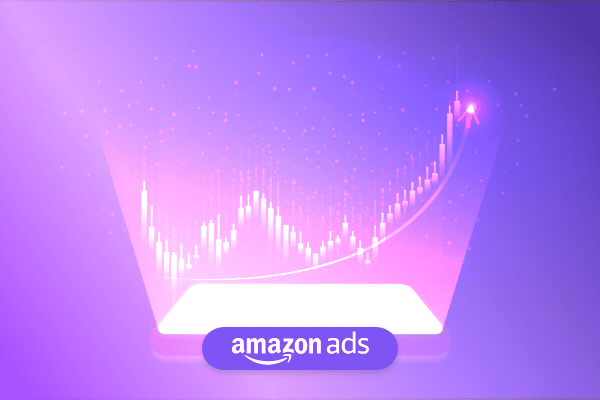Summary
Whether you’re not selling on Amazon yet or looking to enhance your digital advertising strategy, discover how Amazon’s vast data and targeting capabilities can revolutionize your ad campaigns. Explore the expansive possibilities of Amazon Ads for non-endemic advertisers in this comprehensive guide.
When it comes to digital advertising, Amazon Ads is pretty hard to ignore. Now, as the third-largest digital publisher behind just Google and Meta, Amazon is a major player in the industry with nearly 20% of U.S. search advertising share.
With its robust commerce insights on over 300 million active customers worldwide, Amazon Ads can reach people based on what brand, products, and categories they search for, browse, and purchase. And that’s just the tip of the iceberg in terms of the kinds of signals Amazon Ads is able to offer its advertisers. This data can help all kinds of businesses connect with buyers at every stage of their journey.
If you are a service company or one that does not sell products on Amazon, you likely assume that you can’t use Amazon Ads.
But you’re wrong.
In 2022, Amazon announced plans to offer ads to non-endemic brands — ones that don’t sell on Amazon — cementing itself as a publisher that all brands should take seriously.
Here’s everything non-endemic advertisers need to know about Amazon Ads.
What is Amazon Ads?
Amazon Ads is Amazon’s advertising arm, known for offering highly targeted sponsored messaging across Amazon-owned properties. It has three core characteristics:
- Targeted reach. Amazon Ads taps into a vast, intent-driven audience, offering precise targeting based on shopping behaviors.
- Complete Control. With Amazon Ads, advertisers have the opportunity for 24/7, 360-degree control over their campaigns, enabling instant adjustments to budgets, bids, and targeting for real-time optimization.
- Data-driven insights. Advertisers get detailed analytics for optimizing campaigns and understanding the direct impact on sales.
While Amazon sellers often focus on visibility within Amazon search results, for non-endemic advertisers, it’s important to understand that the possibilities for reaching audiences with Amazon Ads extend far beyond search results. Amazon Ads can appear anywhere within Amazon’s dynamic portfolio, including Twitch, IMDB, Zappo, across social media, and so much more. Alone, Prime Video reaches an estimated 115 million monthly viewers in the U.S. per month.
But the best thing about Amazon Ads for non-endemic advertisers is that even when ads appear off-Amazon, they’re still triggered by Amazon’s vast stores of first-party data. This is especially significant in 2024 as the industry faces new limitations on consumer data. All advertisers looking for data-driven, precision targeting should look to Amazon Ads as one of the best ways to discover new audiences and gain insights about customers’ paths to purchase — no third-party data required.
According to recent studies, about half of consumers begin their product research on Amazon, with 94% of those shoppers relying on its reviews and videos to inform their purchase decisions. An Amazon shopper searching for “one-piece women’s swimwear” is obviously valuable to a company that sells swimsuits.
But that search could also be helpful to companies that offer related services, even if they don’t sell on Amazon. For example, a person searching for swimsuits and beach towels might also be searching elsewhere for top beach resorts. Hospitality brands and cruise lines could use this data to define messaging, then use sales and impression data from non-endemic Amazon Ads campaigns to better inform future targeting.
How can non-endemic advertisers use Amazon Ads?
Amazon sellers have long used Amazon Ad’s precision targeting to find shoppers at every stage of the purchase funnel with ads. Still, for non-endemic advertisers, using Amazon Ads is likely a new concept.
Here are some innovative ways to use Amazon’s data to find new audiences and reconnect with brand loyalists across Amazon’s network:
Targeting by demographics
You can think of Amazon Ads as you would any other online or offline media plan — by demo.
All of the standard demo targeting options are available. Use Amazon Ad’s data to tailor ads to consumers based on specific age groups or characteristics, including age, gender, presence of children in the household, household income, education level, and more.
Find customers based on purchase habits
Advertisers who don’t sell on Amazon can still gain plenty of insights from data about buyers who frequently purchase items within specific categories. An ophthalmologist might want to reach out to customers who purchased reading glasses, or a local vet might serve ads to those Amazon users who frequently purchase cat litter.
Find audiences based on life stages
Purchase data also speaks to where consumers are in their lives. An Amazon shopper browsing lawn furniture, grills, and outdoor pizza ovens is likely a new homeowner or doing some major outdoor renovations. That data could be useful to a landscaping company looking for new customers.
Analyze non-purchase behavior for engagement
As audiences browse Amazon, they leave behind a trail of clues as to the kinds of content they’re looking for. Users watch videos, engage with ads, and add items to their carts. Each of these actions should inform advertisers about the kinds of content that will resonate.
Consider a scenario where you’ve introduced a novel product that requires some explanation to grasp its full value. In this case, targeting ads toward users who have watched explainer videos would be a great way to offer educational content to audiences highly likely to convert.
Tailor ads to devices
The device on which users are browsing Amazon-owned properties is a valuable data point. Amazon ads allow non-endemic users to segment audiences based on device, including factors like make, operating system, and device type. This is particularly important data if you’re selling accessories or tools designed for specific devices. Advertising an app that only runs on iOS to a Windows user is a waste of ad spend and vice versa. Amazon can help advertisers easily find the perfect users for niche tech products.
Make the most of the context
Amazon Ads can direct ads to consumers based on the specific type of content they are currently browsing in real time. For instance, a Twitch user watching a discussion of a particular game could be instantly served an ad for a similar game, providing on-the-spot campaign insights for advertisers.
Create custom audiences
You don’t even need Amazon’s data to reach your best customers. Amazon Ads also allows advertisers to utilize their own first-party data to create highly customized audiences. Similar to Google Ads or Facebook Ads, marketers can upload their customer lists, which Amazon anonymously matches to their users.
This enables you to reach your most valuable audiences through Amazon’s network and stay top-of-mind as users engage with Amazon’s marketplace and other Amazon-owned properties. For example, a financial services brand can just push ads to their audience while they’re shopping online.
Easily build lookalike audiences
Additionally, you can easily expand your reach beyond your customer lists by creating lookalike audiences across the platform. These audiences share affinities and other characteristics with the audience you’ve selected, allowing you to broaden your target base. Amazon Ads’ sophisticated algorithms ensure that the new people you are targeting have some characteristics and behaviors similar to those of your core customers. It may not mean that they are actively looking for whatever you’re selling, but
Remember that customer shopping for swimwear? What if you could reach every Amazon shopper searching for sunblock across hundreds of Amazon subsidiaries? With Amazon Ads, that’s actually within reach.
Still on the fence? Remember that your competitors are probably already getting started with Amazon Ads. Early adoption means the difference between establishing your business within the Amazon ecosystem and playing catch up with brands that have already found their audiences in the Amazon ecosystem.
How to get started
Visit Amazon Ad’s sales form with its straightforward title: Sponsored Display for brands that don’t sell on Amazon (beta):
Businesses that sell products and services in verticals that are not available on Amazon can now run Sponsored Display campaigns using Amazon Ads audience insights and unique ad inventory to help grow their business. With an easy-to-use interface and no minimum spend requirements, Sponsored Display unlocks the power of Amazon Ads for any self-service advertiser. Submit your details below to apply to participate in a closed beta to test this new feature.*
*Note: There are some extra notes and fine print on that page to read if you are thinking about filling out the form.
Account setup. Begin by setting up your Amazon Ads account, making sure all business information and payment methods are correctly entered.
Get trained. Become acquainted with Amazon Ads, familiarizing yourself with its functionalities, tools, and analytics features. It has a fantastic learning center with on-demand training to teach you everything you need to know to become an Amazon Ads mater.
Make your ads. Create compelling ad creatives that comply with Amazon’s guidelines, incorporating several best practices for maximum impact:
- Use high-resolution images to immediately draw attention and convey quality.
- Write clear, concise ad copy that communicates unique value and includes a strong call to action.
- Maintain brand consistency across all creative assets to build recognition and trust.
- Perform A/B testing to determine the most effective ad components, from visuals to text.
Website optimization. There’s no reason to waste money on Amazon Ads if you’re not fully prepared to handle that traffic. Ensure your website or landing page is primed for increased traffic, with a focus on fast load times, mobile responsiveness, and clear pathways to conversion.
Test and learn. Start your campaigns with limited budgets to test creatives, targeting, and messaging, and analyze the data to understand what engages your audience. Make sure you give campaigns 1-2 weeks to run before you evaluate their performance. Most digital ad platforms require a ramp-up period to best figure out where and when to serve your ads.
Optimize — then repeat. Continuously refine your campaigns based on insights gathered, scale successful elements, and consistently seek new ways to enhance ad performance and conversions. Every campaign should be a learning experience
A Skai + Amazon Ads non-endemic success story
Goodway Group, a digital marketing agency, sought to enhance the digital reach and engagement of a professional sports team using Skai’s advertising technologies. Their strategic focus was on broadening the audience by targeting non-endemic users through channels such as Amazon’s Sponsored Display and Facebook. The goal was to not only expand their reach but also to engage more deeply with the new audience segments they targeted.
Key results from the implementation included:
- A 35% increase in audience reach across non-endemic markets.
- Improvement in engagement rates by 28% on targeted social media platforms.
- A notable rise in the conversion rate, with a 50% increase in audience interaction compared to previous campaigns.
For further details, you can access the full case study here.
New to Amazon Ads? Do you have the right foundation in place?
Skai’s Retail Media solution empowers marketers to plan, execute, and measure digital campaigns that meet consumers when and where they shop. As part of our omnichannel platform, you can connect the walled gardens and manage campaigns on 100+ retailers, including Amazon, Walmart, Target, and Instacart, alongside major publishers across paid search, paid social, and apps.
The future of retail media is bright but will usher in new omnichannel complexities that your current tech solution may need help to handle.








